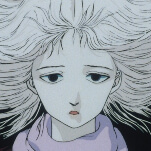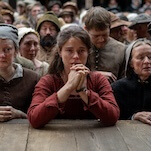A woman strolls through a time-worn city square. The emerald green of her hat pops against the backdrop, which is stern and overcast, illuminated in spots by carousel lights and the friendly smile of a police officer. She enters a gourmet emporium, ordering items in a language that isn’t her native tongue. There she notices a rabbit, suspended by its hind legs and freshly killed. Blood runs down its face, its red as distinct as the green of the woman’s hat. We next see the woman, purse in her lap, waiting for a train she doesn’t board. The routine is conducted in near silence, save for the woman’s grocery order and the organ soundtracking her errands. It seems inconsequential, but this is a typical scene from “Antipasto,” the third season premiere of Hannibal. It’s also one of the most unsettling.
Hannibal’s second season finale, “Mizumono,” blew up the show’s status quo, but it didn’t prepare viewers for how much Bryan Fuller’s Red Dragon doesn’t resemble itself in “Antipasto.” After leaving his colleagues-turned-adversaries bleeding out on his kitchen floor, Dr. Hannibal Lecter (Mads Mikkelsen) has successfully escaped to Europe, his former therapist, Dr. Bedelia Du Maurier (Gillian Anderson), at his side. Their adopted European digs suit the cannibalistic fugitive’s refined palate, and streets full of strangers who don’t know the name “Hannibal Lecter” satisfy his dark predilections. But the atmosphere there is hazier, the Old World architecture more suggestive of a dream state than any of the couple’s former East Coast surroundings. In transplanting their characters to the continent, Fuller and the Hannibal team draw upon the traditions of past horror works set there: The vivid colors and extreme closeups of Giallo, the moody moors of vintage Hammer. Occasionally, analog keyboard textures snake through Brian Reitzell’s instrumental score, injecting a hint of Goblin into the proceedings.
“Antipasto” is one of the strangest premiere episodes in recent memory, a function of the new setting as well as what happens there. Hannibal and Bedelia question one another as if he’s in a session with her but doesn’t know it (and vice versa). It’s a doubling down on the show’s elliptical, philosophical dialogue that further untethers season three from expectation—to say much more borders on giving away Hannibal’s secrets. Those who come seeking concrete answers to the questions raised by “Mizumono” will walk away disappointed, though they don’t have to look much further than the opening credits or the nearest “first look” trailer to learn who’s still among the living. So it goes with a TV adaptation that continues to surprise three years into its run, even as it works from some of the most chewed-over source material in the modern pop-culture canon. Unlike most shows that reach for the “reset” button, Hannibal wasn’t in a position where it needed a new beginning. It’s just the logical, natural place to go, and the fresh slate makes startling hay from the unknowns.
Part of that reset involves pivoting Mikkelsen’s character, fully displaying the wicked streak he’s only previously shown the viewers at home. In Italy, he’s rechristened “Il Mostro,” the prime suspect in a string of gruesome killings that terrified the city many years before. Just as Will Graham (Hugh Dancy) had to un-shatter the tea cup of his psyche in season two, he must now re-assemble the pieces of Dr. Lecter. He visits the physical spaces that make up wings in Hannibal’s memory palace and picks up bread crumbs that may be intentionally placed to lead Will and Jack Crawford (Laurence Fishburne) to their quarry. The myth-making and profiling techniques applied to other Hannibal big bads are now applied to the man himself, producing cat-and-mouse thriller beats worthy of the first director to put these characters on the big screen. When one episode climaxes in a subterranean chase, it’s as straightforwardly spine-tingling as Hannibal gets.
While the show finds new ways of quickening pulses, it continues to revel in visual decadence. Season three drops its players into locations of Renaissance and Byzantine origin, crumbling relics and gilded cathedrals after Dr. Lecter’s own heart. When the premiere casts flashbacks in super saturated black-and-white, it melds film history with art history in compelling fashion, depicting a crime that needs no blood to appear horrifying. Perhaps the rest of the season left no vital fluids to spare: On Hannibal any opening—physical or architectural—can be the elevators at the Overlook Hotel, gushing liquids that threaten to drown Will and Bedelia. Once upon a time, water was a calming element in Will’s recovery, his desired bliss symbolized by a fly-fishing stream. But now that Hannibal has shown his true face, the carnage he yields pollutes the waters.
In Europe, Hannibal still gets by on games of lies and manipulation. But the reveal of his secret identity leads to a lot of shots where Mikkelsen is set in the dead center of the frame, peering into the distance, turning Dr. Lecter’s conversations with other characters into direct addresses about the nature of (his) evil and the depths of (his) psychosis.. The device is not entirely new to the franchise: Jonathan Demme used it to chilling effect with Anthony Hopkins in The Silence Of The Lambs. But it’s spookier here, partly due to the demure manner of Mikkelsen’s pre-apprehension Hannibal, partly because his intended audience, Will Graham, is thousands of miles away. But he’s getting closer every day. Hannibal begins its third season in a fog, but eventually makes this much clear: We know how this story ends, but the journey to that destination can still be bloody fun.









































